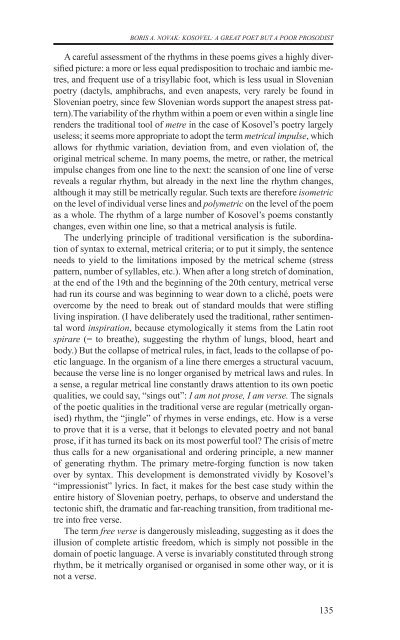razprave (pdf) - Društvo za primerjalno književnost - ZRC SAZU
razprave (pdf) - Društvo za primerjalno književnost - ZRC SAZU
razprave (pdf) - Društvo za primerjalno književnost - ZRC SAZU
- No tags were found...
You also want an ePaper? Increase the reach of your titles
YUMPU automatically turns print PDFs into web optimized ePapers that Google loves.
oris a. novak: KOSOVEL: A GREAT POET BUT A POOR PROSODISTA careful assessment of the rhythms in these poems gives a highly diversifiedpicture: a more or less equal predisposition to trochaic and iambic metres,and frequent use of a trisyllabic foot, which is less usual in Slovenianpoetry (dactyls, amphibrachs, and even anapests, very rarely be found inSlovenian poetry, since few Slovenian words support the anapest stress pattern).Thevariability of the rhythm within a poem or even within a single linerenders the traditional tool of metre in the case of Kosovel’s poetry largelyuseless; it seems more appropriate to adopt the term metrical impulse, whichallows for rhythmic variation, deviation from, and even violation of, theoriginal metrical scheme. In many poems, the metre, or rather, the metricalimpulse changes from one line to the next: the scansion of one line of versereveals a regular rhythm, but already in the next line the rhythm changes,although it may still be metrically regular. Such texts are therefore isometricon the level of individual verse lines and polymetric on the level of the poemas a whole. The rhythm of a large number of Kosovel’s poems constantlychanges, even within one line, so that a metrical analysis is futile.The underlying principle of traditional versification is the subordinationof syntax to external, metrical criteria; or to put it simply, the sentenceneeds to yield to the limitations imposed by the metrical scheme (stresspattern, number of syllables, etc.). When after a long stretch of domination,at the end of the 19th and the beginning of the 20th century, metrical versehad run its course and was beginning to wear down to a cliché, poets wereovercome by the need to break out of standard moulds that were stiflingliving inspiration. (I have deliberately used the traditional, rather sentimentalword inspiration, because etymologically it stems from the Latin rootspirare (= to breathe), suggesting the rhythm of lungs, blood, heart andbody.) But the collapse of metrical rules, in fact, leads to the collapse of poeticlanguage. In the organism of a line there emerges a structural vacuum,because the verse line is no longer organised by metrical laws and rules. Ina sense, a regular metrical line constantly draws attention to its own poeticqualities, we could say, “sings out”: I am not prose, I am verse. The signalsof the poetic qualities in the traditional verse are regular (metrically organised)rhythm, the “jingle” of rhymes in verse endings, etc. How is a verseto prove that it is a verse, that it belongs to elevated poetry and not banalprose, if it has turned its back on its most powerful tool? The crisis of metrethus calls for a new organisational and ordering principle, a new mannerof generating rhythm. The primary metre-forging function is now takenover by syntax. This development is demonstrated vividly by Kosovel’s“impressionist” lyrics. In fact, it makes for the best case study within theentire history of Slovenian poetry, perhaps, to observe and understand thetectonic shift, the dramatic and far-reaching transition, from traditional metreinto free verse.The term free verse is dangerously misleading, suggesting as it does theillusion of complete artistic freedom, which is simply not possible in thedomain of poetic language. A verse is invariably constituted through strongrhythm, be it metrically organised or organised in some other way, or it isnot a verse.135
















